Elizabeth I (1533 - 1603)
Elizabeth I (7 September 1533 - 24 March 1603) was the queen of England and Ireland from 17 November 1558 until her death.
Elizabeth was born at Greenwich Palace and was named after both her grandmothers, Elizabeth of York and Elizabeth Howard. She was the second child of Henry VIII and Henry's second wife, Anne Boleyn. At birth Elizabeth was the heiress presumptive to the throne of England. Her older half-sister, Mary, had lost her position as a legitimate heir when Henry annulled his marriage to Mary's mother, Catherine of Aragon, to marry Anne and sire a male heir to ensure the Tudor succession. Elizabeth was baptised on 10 September; Archbishop Thomas Cranmer, the Marquess of Exeter, the Duchess of Norfolk and the Dowager Marchioness of Dorset stood as her four godparents.
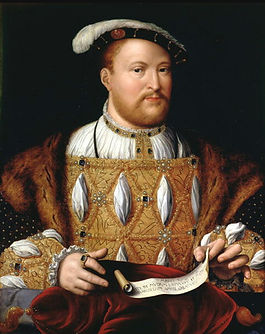
Henry VIII by Joos Van Cleve, in 1533
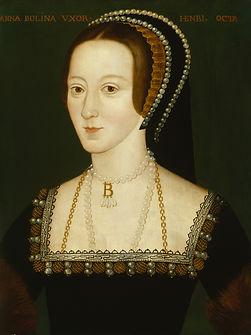
Anne Boleyn, around 1533
At the head of Elizabeth's little establishment was Lady Mistress, Margaret Bryan, who had fulfilled the same role for Henry VIII's first daughter, Mary. In December came the decision to set up an independent house for the little princess. The house chosen was Hatfield, situated in pleasant and airy countryside, where a little court was established. In the spring of 1534, Anne came all the way to Hatfield to see Elizabeth and make sure that she was settled into her new life.
When Elizabeth was two years and eight months old, her mother was executed on 19 May 1536. Thereafter, the two sisters lived amiably under the same roof, and, at times, they became really close. Also important in the reconciliation was Henry's new wife, Jane Seymour, who went out of her way to show favour to Mary, not forgetting Elizabeth. But Jane's great achievement was in giving birth to the longed-for son, Edward, who was undisputed heir apparent to the throne.
The pattern shifted again with Jane Seymour's sudden death from puerperal fever on 24 October 1537. Her son was sent to be brought up with his sisters' household and they both became genuinely fond of him: Mary was motherly in a distant kind of way; Elizabeth was much closer as a sister to a clever little brother.
After Edward's birth, Elizabeth lost her nurse, Margaret Bryan, who was transferred to the young prince's household. She was placed in the care of Blanche Herbert, who remained Elizabeth's governess until she retired in late 1545 or early 1546. Katherine Champernowne was appointed as a waiting gentlewoman to Elizabeth in July 1536. Evidently, Champernowne had been well educated for she taught Elizabeth astronomy, geography, history, mathematics, French, Flemish, Italian and Spanish. In addition, she taught Elizabeth pursuits such as needlework, embroidery, dancing, riding and deportment. By the time William Grindal became her tutor in 1544, Elizabeth could write English, Latin and Italian. Under Grindal, a talented and skilful tutor, she also progressed in French and Greek. After Grindal died in 1548, Elizabeth received her education under Roger Ascham, a sympathetic teacher who believed that learning should be engaging. By the time her formal education ended in 1550, she was one of the best educated women of her generation. By the end of her life, Elizabeth was also reputed to speak Welsh, Cornish, Scottish and Irish in addition to English.
Henry VIII's obesity hastened his death at the age of fifty-five, which occurred on 28 January 1547 in the Palace of Whitehall. Those close to the throne, led by Edward Seymour and William Paget, agreed to delay the announcement of the king's death until arrangements had been made for a smooth succession. Since Edward was then only nine years old, he could not exercise actual power. Henry's will designated the executors to serve on a council of regency until Edward reached the age of eighteen. They chose Edward Seymour, 1st Earl of Hertford, Jane Seymour's brother, to be the Protector of the Realm.
Catherine Parr retired from court after the coronation of her stepson, Edward VI, on 31 January 1547, to her home at Old Manor in Chelsea, and it was there that Elizabeth joined her soon after Henry's death. Catherine was quick to accept when Thomas Seymour renewed his suit of marriage. Since only six months had passed since the death of Henry VIII, Seymour knew that the Regency council would not agree to a petition for the queen dowager to marry so soon. Sometime near the end of April 1547, Catherine and Seymour married in secret.
Thomas Seymour was physically impressive; tall, well-built and with a dashing beard and auburn hair, he was very irresistible to women. So inevitably, Elizabeth fell for him. He engaged in romps and horseplay with the fourteen-year-old girl. These included entering her bedroom, tickling her and slapping her on the buttocks. He snatched kisses from Elizabeth, stole embraces from her under Catherine's very nose. But most extraordinary were the incidents where Seymour's antics were actually assisted by his wife.
Early on two mornings, for instance, Catherine joined her husband in his visit to Elizabeth's bedchambers, where they both tickled the girl in bed. Later, in the garden, Catherine held Elizabeth while Seymour cut her dress into a hundred pieces. By May 1548, however, Catherine had decided that things had gone too far. So Elizabeth was sent off to stay with Anthony Denny and his wife at Cheshunt. Denny was one of the leading figures of the new regime, while his wife Joan was Katherine Champernowne's sister.
When Catherine Parr died after the childbirth on 5 September 1548, Thomas Seymour renewed his attentions towards Elizabeth, intent on marrying her. As if his marital schemes were not enough, Seymour was also intriguing directly with the king against his brother, Edward Seymour, 1st Duke of Somerset, who kept the king on short rations; this made Edward an easy target for Seymour's gifts of money and little luxuries. Seymour was reported even to be planning to capture probably willing Edward and use his possession of the young king's person to force a change of government. The Duke of Somerset had no choice; Seymour was arrested, interrogated, condemned and beheaded on 20 March 1549.
By the winter 1553 Edward was seriously ill and in the spring it was clear to those nearest to him that he was suffering from consumption or tuberculosis, which was incurable in the sixteenth century. On the evening of 6 July 1553 Edward died in the arms of Sir Henry Sidney, Northumberland's son-in-law. His will swept aside the Succession to the Crown Act 1543, excluded Mary and Elizabeth from the succession, and instead declared as his heir - Lady Jane Grey, who was proclaimed queen by the Privy Council, but her support quickly crumbled and she was deposed after nine days.
Mary had remained in her own house at New Hall (Beaulieu) in Essex while her opponents were mopped up and put under arrest. Then, on 3 August, she rode triumphantly into London, with Elizabeth at her side. The show of solidarity between the sisters did not last long. Mary, a devout Catholic, was determined to crush the Protestantism in which Elizabeth had been educated, and she ordered that everyone attend Catholic Mass; Elizabeth had to outwardly conform.
Mary's popularity receded when she announced plans to marry Philip of Spain, the son of Holy Emperor Charles V and an active Catholic. Discontent spread rapidly through the country and many looked to Elizabeth as a focus for their opposition to Mary's religious policies. In January and February 1554, Wyatt's rebellion broke out, however it was soon suppressed. Elizabeth was brought to court and interrogated regarding her role and, on 18 March, she was imprisoned in the Tower of London. Though it is unlikely that she had plotted with the rebels, some of them were known to have approached her.
Mary's confidant, Spanish ambassador Simon Renard, argued that her throne would never be safe while Elizabeth lived; and Stephen Gardiner worked to have Elizabeth put on trial. Elizabeth's supporters in the government convinced Mary to spare her sister in the absence of hard evidence against her. On 22 May 1554 Elizabeth was moved from the Tower to Woodstock, where she was to spend almost a year under house arrest in the charge of Sir Henry Bedingfield.
On 17 April 1555, Elizabeth was recalled to court to attend the final stages of Mary's apparent pregnancy. Her rooms were secure and had a secret access to the royal apartments. On 30 April came the news that the queen was safely delivered and of a son. But the next day the tidings turned out to be false. Mary herself remained invincible in her hopes and believed that she remained pregnant still. When it became clear that Mary was not pregnant, no one believed any longer that she could have a child.
During these months Elizabeth was at her sister's side. She witnessed both her physical and her mental anguish. But what probably shocked her more, as a true believer in monarchy, was the damage done to the queen's public reputation.
Elizabeth obtained permission to leave court for her own estates on 18 October 1555. Eventually she reached Hatfield and there the former tenor of her life resumed. For Mary there could be no such retreat into a familiar world. So long as she was wrestling with personal agonies of her false pregnancy and Philip's departure, Mary seems to have found solace in Elizabeth's company. But now that the queen had once more to take up the burdens of government - and to take them up alone - her sister became a distraction, even a danger.
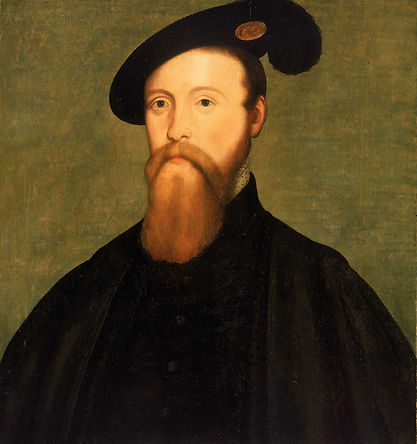
Thomas Seymour, 1st Earl of Hertford by Nicholas Denizot, around 1545 - 1549
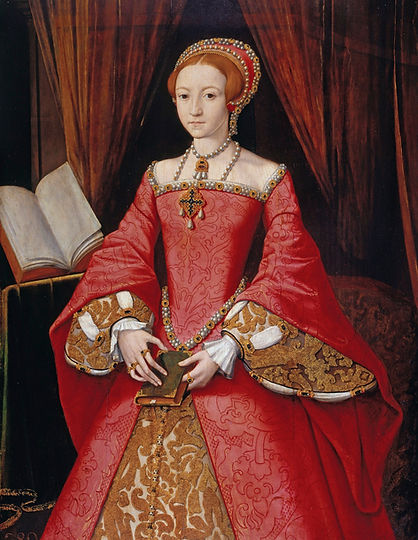
Elizabeth Tudor, around 1546
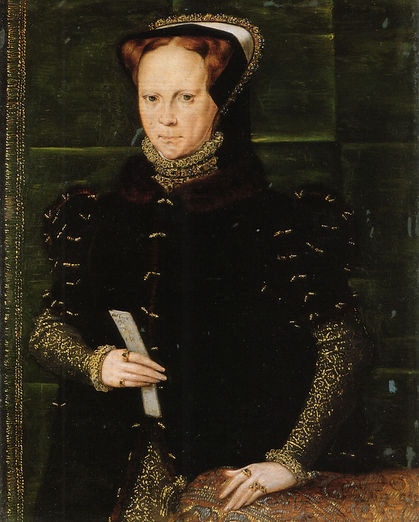
Mary I by Hans Eworth, around 1555
In August 1558 Mary seems to have fallen victim to the pandemic of influenza, which hit England repeatedly in 1560s. It did not kill her, but it exacerbated her underlying medical condition. Her health fluctuated in September; then, in early October, she became dangerously ill. Her doctors started sending the regular bulletins to Philip, and the news obviously reached Elizabeth.
On 6 November Mary bowed to the inevitable and accepted Elizabeth as her heir. On 16 November, towards midnight, she received the last rites. A few hours later, she was able to make the responses at the early morning mass, which, as usual, was said in her bedchamber. Then she slipped away; no one noticed the precise time, so gently had body and soul parted. She whose life had been a catalogue of trouble had the most peaceful of deaths.
On 17 November 1558, Elizabeth summoned those councillors who had arrived at Hatfield to attend her to discuss her immediate plans. The next morning they met to make arrangements for the royal household and later that day the appointment of Robert Dudley as Master of the Horse was announced. It suited him, as he was an excellent horseman and showed great professional interest in royal transport and accommodation, horse breeding and the supply of horses for all occasions. Lord Dudley was also entrusted with organising and overseeing a large part of the queen's coronation festivities.
Throughout 18 and 19 November Elizabeth worked with her advisers to form a new administration, and on 20 November she made her first public speech. First, Sir William Cecil's appointment as Secretary of State was announced, and he took the oath of office. The office of Secretary was not the greatest that the queen could bestow, but it would enable her to form a close working relationship with Cecil, whom she trusted above all other men. The rotund and amiable lawyer Sir Nicholas Bacon was then sworn in as Lord Keeper of the Great Seal, then other appointments were announced. Catherine Parr's brother William, out of favor under Mary, was restored to the Marquessate of Northampton and made a Privy Councillor; Sir Nicholas Throckmorton, a zealous and vocal Protestant, became Chamberlain of the Exchequer. Sir Francis Knollys, another fanatical Protestant, who was hurrying home from exile upon receiving news of Elizabeth's accession, was the husband of the queen's cousin Catherine Carey, daughter of Anne Boleyn's sister Mary, and was made a Privy Councillor.
On 23 December Elizabeth moved to Whitehall Palace, which was to be her principal, if not her favourite, residence. The young queen had from the first established a set daily routine. She rose early and went in all but the worst weather for a brisk walk in the palace gardens. She then had breakfast served to her in her Privy Chamber, where she would remain while she attended to the day's business, summoning her secretaries, who would kneel before her to present letters and documents that needed the royal signature. In the evenings there were state banquets or courtly entertainments to attend. Elizabeth loved music of all kinds and welcomed many performers at her court. Later in the evening she would play cards with her courtiers, but she usually worked for an hour or so on state papers before retiring to bed, and was not above summoning Cecil and other councillors at all hours of the night is she wanted some advice.
On 15 January 1559, Elizabeth was anointed and crowned by Owen Oglethorpe, the Catholic bishop of Carlisle, in Westminster Abbey. Now that she was firmly established on her throne, Elizabeth turned her attention to the urgent matters of state that would be debated in her first Parliament (on 25 January 1559). Two issues seemed likely to dominate the session: the controversial subject of religion and the more delicate matter of the queen's marriage.
The Act of Supremacy 1558 revived 10 acts which Mary had reverted, significantly clarified and narrowed the definition of what constituted heresy, and confirmed Elizabeth as Supreme Governor of the Church of England. At the same time, a new Act of Uniformity was passed, which made attendance at church and the use of an adapted version of the Book of Common Prayer of 1552 compulsory, though the penalties for recusancy, or failure to attend and conform, were not extreme. The mass was outlawed and all services were to be in English. The Acts of Supremacy and Uniformity were passed on 29 April 1559, and received Elizabeth's approval on 8 May 1559, making Protestantism the official religion of the state.
In the spring of 1559 it became evident that Elizabeth was in love with Robert Dudley. His duties brought him into daily contact with her and there were plenty of opportunities for their relationship to flourish. They rode out together most days since both of them shared a passion for hunting. He was cultivated, witty, charming and attractive: in fact, a stimulating companion. When she was with him, she was anything but discreet, making no secret of her affection for him.
There can be little doubt that the love between Elizabeth and Dudley was genuine on both sides. It endured through many storms until death intervened. There is no escaping the sincerity in Dudley's letters, the warmth of his addresses, nor his obvious concern for her welfare. He was attracted to redheads, and enjoyed a sexual rapport with the queen. It is also true that his feelings for her were not entirely selfless, yet she too was not above using him for her own ends.
For Elizabeth, Robert Dudley had one supreme advantage over all her other male admirers. He could not offer her marriage. With his wife safely living in the country - Amy Dudley came rarely to London, and her husband's duties gave him leisure to visit her only infrequently - the queen could enjoy all advantages of male companionship without having to commit herself to marriage or the surrender of her body.
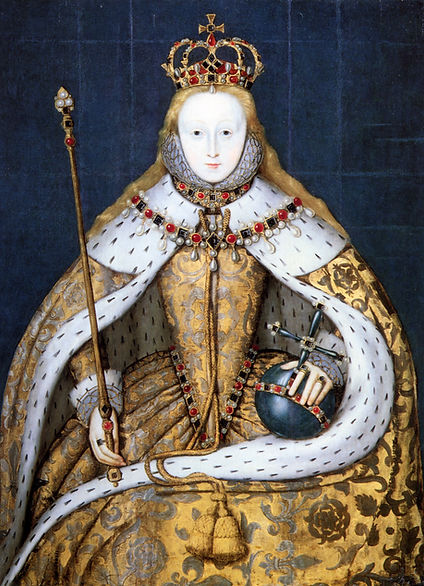
Elizabeth I in her coronation robes.
Copy around 1600-1610 of a lost original around 1559.
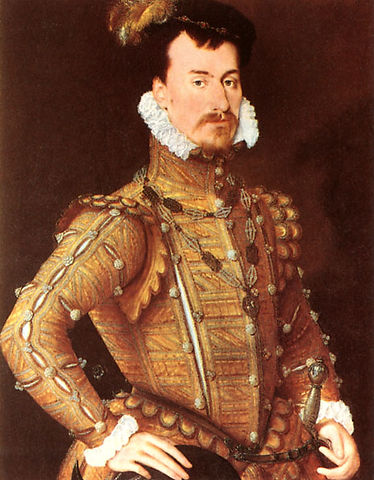
Robert Dudley by Steven van der Meulen, around 1560
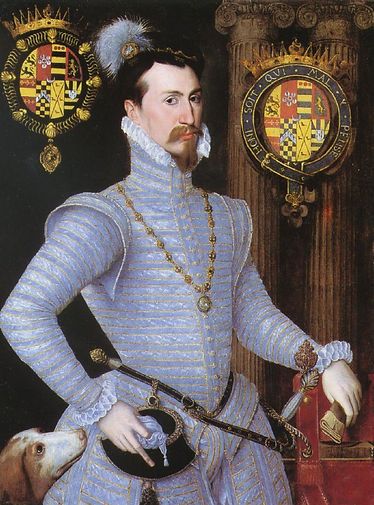
Robert Dudley, Earl of Leicester, around 1564

Amy Dudley lived in different parts of the country since her ancestral manor house was uninhabitable. In early September 1560 Amy Dudley became very depressed. This depression could have been the result of hearing that her husband was only waiting for her to die so that he could marry the queen, or it could have been caused by the knowledge that she herself was mortally sick. On Sunday, 8 September, the day of a fair at Abingdon, Amy Dudley was found dead at the foot of a pair of stairs at Cumnor Place.
Robert Dudley was with the queen at Windsor Cadtle and was told of her death by a messenger on 9 September. Retiring to his house at Kew, away from court as from the putative crime scene, Dudley pressed for an impartial inquiry which had already begun in the form of an inquest. The jury found that it was an accident: Amy Dudley had fallen down the adjoining stairs, sustaining two head injuries and breaking her neck. It was widely suspected that Dudley had arranged his wife's death to be able to marry the queen. The scandal played into the hands of nobles and politicians who desperately tried to prevent Elizabeth from marrying him. Some of these, like William Cecil and Nicholas Throckmorton, made use of it, but did not themselves believe Dudley to be involved in the tragedy which affected the rest of his life.
Smallpox was exeptionally virulent during the early years of Elizabeth's reign and in the 1560s reached epidemic form. Elizabeth was at Hampton Court when, on 10 October 1562, she first felt unwell. Believing, as many did then, that it would effect the cure, she immersed herself in a bath, then took a bracing walk outdoors; as a result, she caught a chill. Within hours, she had taken to her bed, running a high temperature. By 16 October she was very ill indeed, becoming incapable of speech and lapsing into an unconscious state in which she remained for twenty-four hours.
Elizabeth was aware that she was dangerously ill and her chief concern was to make provision for the government of England after her death. Turning to the only one man she felt she could trust, she commanded the councillors to appoint Robert Dudley Lord Protector of England. There was universal relief when she recovered her health: Dudley was made a privy councillor.
Dudley was still riding the crest of success. In June 1563, Elizabeth bestowed upon him Kenilworth Castle in Warwickshire, a huge medieval fortress that had been converted by John of Gaunt into a luxurious palace. Now Dudley would have a country seat of his own, just five miles south of Warwick Castle, the residence of his older brother Ambrose, and he wasted no time in drawing up elaborate plans for its improvement and renovation in order to make it a fit place to entertain the queen.
When Mary Stuart returned to Scotland in August 1561 to take up the reins of power, the country had an established Protestant church and was run by a council of Protestant nobles supported by Elizabeth. In March 1564 Elizabeth proposed Robert Dudley as a husband for Mary, without asking either of the two people concerned; the idea being to achieve firm amity between England and Scotland and diminish the influence of foreign powers. Mary's lack of enthusiasm for the marriage was shared by Dudley himself, who was panic-stricken at the prospect of leaving England for what he perceived to be a land of barbarians, and even more distraught at the thought of leaving Elizabeth, whom he still cherished some hopes of marrying her.
Mary at first enquired if Elizabeth was serious, wanting above all to know her chances of inheriting the English crown. Mary's Protestant advisors warmed to the prospect of having Dudley as their prince, and in September 1564 he was created Earl of Leicester, a move designed to make him more acceptable to Mary. But Mary, on 18 April 1565, informed Elizabeth that she had decided to marry Henry Stuart, Lord Darnley, who through his parents had claims to both the Scottish and English thrones, as he was descended from both James II of Scotland and Henry VII of England.
In the summer 1565 Dudley had begun a flirtation with Elizabeth's cousin and confidante - the red-haired Lettice Knollys, who had been married four years before to Viscount Hereford and was 'one of the best looking ladies at the court'. She was the daughter of Sir Francis Knollys by Catherine Carey, whose mother, Mary Boleyn, had been sister to Elizabeth's mother, Anne Boelyn. In retaliation, a jealous Elizabeth began to show especial favour to one of Dudley's friends, Thomas Heneage. Dudley was angry at the attention shown to Heneage and there were clashes between the two men. Elizabeth summoned him to Windsor, where a violent quarrel took place, with Dudley accusing her of casting him aside for another, and Elizabeth flinging the same complaint back at him and declaring she was sorry for the time she had wasted on him.
Suitably admonished, Dudley shut himself in his apartments for the next few days, whilst Heneage was sent quietly from the court. Then, against his better judgements, William Cecil persuaded the queen and Dudley to make up. The queen summoned him to her presence and, both weeping, they were reconciled. For Dudley, however, it was the end of an era in his life. His relationship with the queen was changing: the passion of first love had gone and with it his conviction that she would indeed eventually marry him.
Thomas Heneage was not the only handsome man to captivate Elizabeth that summer. When her cousin, Thomas Butler, 10th Earl of Ormonde and Lord Treasurer of Ireland, visited court, she began singling him out. He was attractive and admiring, and was often in her company during the next year. Dudley's feelings were shortly afterwards revealed when Elizabeth indulged in further flirtation with Earl of Ormonde, which this time angered Dudley. He quarelled with the queen, achieved nothing, and left court.
On 9 February 1567, the bodies of Henry Stuart, Lord Darnley, and his valet were discovered in the orchid of Kirk o' Field, in Edinburgh, where they had been staying. It was determined that both men were killed by strangulation, believed to have taken place after the explosion. Suspicion fell on James Hepburn, the Earl of Bothwell, and his supporters and Mary Stuart herself. Bothwell had long been suspected of having designs on the throne and his close relationship with the queen gave rise to rumours they were sexually intimate. On 23 April, Mary visited her son at Stirling for the last time and on her way back to Edinburgh, she was abducted, willingly or not, by Bothwell and his men and taken to Dunbar Castle, where he may have raped her. On 15 May, at either Holyrood Palace or Holyrood Abbey, Mary Stuart and Bothwell were married according to Protestant rites.
Robert Dudley by Steven van der Meulen, in 1565
The Scots lords found the marriage intolerable and they were soon preparing for an armed confrontation. This took place on 15 June at Carberry Hill; very little blood was spilt, but at the end of the day Mary was in the custody of her nobles and Bothwell had fled back to Dunbar, whence he escaped to Denmark via the Orkneys. Mary Stuart soon became the focus for rebellion. In 1569 there was a major Catholic rising in the North; the goal was to free Mary, marry her to Thomas Howard, Duke of Norfolk, and put her on the English throne.
Mary Stuart's presence in England and the recent plots and conspiracies against Elizabeth had lent urgency that Elizabeth should marry and produce an heir as soon as possible. Which was why, in August 1569, Elizabeth sent an envoy to the Emperor to try and revive the Habsburg marriage project. The Archduke was still single, but made it clear that he was no longer interested, and the queen pretended indignation at his rejection of her.
Henri, Duke of Anjou, by Jean de Court, in 1570
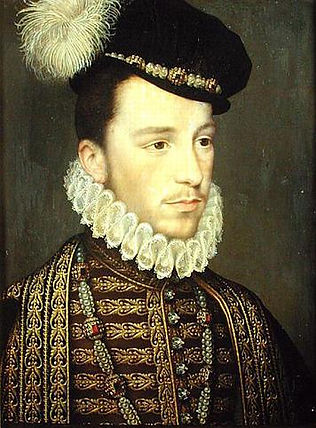
Then, in September, a new proposal of marriage arrived, this time from Charles IX's brother and heir, nineteen-year-old Henry, Duke of Anjou. Charles and Catherine de Medici hoped, by this project, to unite England and France in a defensive alliance against Spain. As usual, religion was to prove a major obstacle in the marriage negotiations, because Elizabeth was as insistent as ever that her husband should abide by her country's laws, and Anjou was adamant that he would never abandon his faith. Elizabeth might well have felt revulsion for the match on personal grounds, because it was well known that Anjou was biosexually promiscuous: at this time he was notorious for being a womeniser, but he was also attracted to men, and in later years became a blatant transvestite, appearing at court balls in elaborate female costumes and with a painted face.
The task of negotiating the marriage was left to Sir Francis Walsingham, England's resident ambassador in Paris. However, the duke now had his sights set on being elected the king of Poland, and was also deeply involved with Mademoiselle de Chateauneuf, whom he was loath to leave, although there was talk of him marrying a Polish princess. If Elizabeth persisted, warned Walsingham, she would almost certainly face a humiliating public rejection.
Catherine de Medici, aware that France still needed Elizabeth's friendship, offered her youngest son, Hercules-Francis, Duke of Alencon, as a replacement bridegroom. Nevertheless, the duke was only seventeen, less than half as old as Elizabeth, and his skin was badly marked after two childhood attacks of smallpox. He had been a weak child, and was undersized for his age.
On 19 April 1572, England and France concluded the Treaty of Blois, under the terms of which they undertook to provide each other with military and naval assistance against their common enemies, mainly Spain. The treaty meant that England was no longer isolated in Europe and it also put an end to the French support of Mary Suart.

In July, Catherine de Medici sent Alencon's good friend, Monsieur de la Mole, in the hope that he would be able to persuade Elizabeth to accept the duke. De la Mole was a handsome, personable young man whose gallant charm was calculated to soften the queen's heart.
The events which took place in France from 24 August 1572 almost wrecked the Anglo-French alliance. On the occasion of the marriage of Charles IX's sister, Marguerite de Valois, to the Protestant Henry of Navarre, the zealously Catholic Guise party, backed by Catherine de Medici, tried to murder Admiral de Coligny, the Huguenot leader, who had incurred the queen mother's jeolousy through his increasing influence over the king. The attempt failed, but it provoked riots and panic in Paris. On 24 August, Catherine de Medici, reluctantly backed by the king, gave the order for the Huguenots to be cleared from the capital. A bloodbath ensued, since the Catholics rose and slaughtered every Huguenot they could lay hands on.
Elizabeth knew she could not seek to avenge the Huguenots because she dared not compromise the alliance, which was so necessary to her and England's security. All she could do was express her deep shock and anger, whilst secretly sending arms to the Huguenots and using her diplomatic influence to protect them.
In March 1574, it was at last agreed that the queen and Alencon should meet, but before this come to pass, the duke was implicated with Henry of Navarre in a series of intrigues against his brother, and was placed under house arrest at St Germain. Then, on 30 May, Charles IX died, probably of the congenital syphilis which was the scourge of the Valois. Charles was succeeded by his brother Anjou, who, hastily summoned from Poland, ascended the French throne as Henri III. He was known to be a fanatical Catholic, who was under the domination of the Guises, and in England fears were expressed that he would end religious toleration in France and might even abandon any alliance with Elizabeth.
Nevertheless, by 1575 Elizabeth had cleared most of her debts, and with the restoration of trade with the Low Countries, England entered a period of economic prosperity. Frendlier relations with Spain had been established, and in April 1575, Henri III ended a year of tension when he requested a renewal of the Treaty of Blois.
In spring 1573, the indications were that Leicester and Douglas, Lady Sheffield had been romantically involved for months, if not years, but had kept their love secret for fear of incurring the queen's wrath. Lady Sheffield was a daughter of the recently dead William, Lord Howard of Effingham, the queen's great uncle and councillor, and had been married, whilst still very young, to Lord Sheffield, who had died in 1568, leaving Douglas a widow at twenty. Shortly afterwards, she had come to court and had attracted Leicester's attention. People had begun to gossip about the affair and rumour had it that in 1571 or 1572, Douglas had become pregnant by Leicester and have given birth at Dudley Castle, the home of her sister, who was married to Leicester's cousin, Edward Dudley,
In May, Leicester agreed that he and Douglas would marry secretly. The ceremony took place at the house at Esher, with at least three witnesses present. Although a validity of the marriage ceremony was later disputed and the parties behaved as if they were free agents, the evidence strongly suggests that it was entirely legal. In August 1574, Douglas had borne Leicester a son, Robert.
By the end of 1575, Leicester had tired of Douglas and was in pursuit of the queen's cousin, Lettice Knollys, daughter of his friend and fellow councillor, Francis Knollys, by Katherine Carey, and wife of Walter Devereaux, Earl of Essex.
Lettice was thirty five and her portrait, painted in 1585, bears witness to her sloe-eyed, seductive beauty. She had been married at twenty to Walter Devereaux, then Earl of Hereford, and had lived there after mainly at Chartley, but although the couple had five children, it seems they were incompatible.
In July 1576, Earl of Essex returned to duty in Ireland, His marriage was foundering and he had quarelled with Leicester over Lettice. Two months later, when he and several other people fell ill with dysentery in Dublin Castle, he concluded that he had been poisoned with 'some evil' in his drink. Neither he nor anyone else at the time suggested that Leicester was responsible. After Essex died on 22 September, he was succeeded in his title by his son, Robert Devereaux.
When Lettice discovered that she was pregnant, Leicester, desperate for legitimate heir, agreed to marry her, and the ceremony took place secretly in the spring of 1578 at Kenilworth.
The discovery of Leicester's marriage put Elizabeth into a bad mood that lasted throughout the summer and drove her councillors to near despair. Subtly, she had set the tone for her future relationship with Leicester: in return for his behaving towards her as if nothing had happened and continuing as her favourite, she was prepared to ignore his unfortunate marriage, as long as he put her needs first. Relieved to have got off so lightly, Leicester played along with this fantasy, but he soon found that there was a heavy price to pay, for Elizabeth, who had once been so affectionate towards her cousin Lettice, now developed an implacable hatred for her and behaved as she did not exist.
Hercules-Francis, Duke of Alencon, by Francois Clouet, in 1572

Elizabeth I (Danley Portrait) by Federico Zuccaro, around 1575

Elizabeth I (Pelican Portrait) by Nicholas Hilliard, around 1575

Elizabeth I (Phoenix Portrait) by Nicholas Hilliard, around 1575
On 8 July 1579, the Council informed Jean de Simier that they had sanctioned a visit by Anjou. His brother, Henri III, objected that it might be unwise, but the duke ignored him and went to England, heavily disguised, in the middle of August, To ensure secrecy, Simier was assigned a pavilion in the gardens of Greenwich Palace, where Anjou would lodge with him.
The duke arrived at Greenwich early in the morning of 17 August, and went directly to Simier's pavilion, where he woke him up and demanded to see the queen. When Simier pointed out that she was still asleep, the eager Anjou had to be restrained from going to wake her up and kiss her hand. At sunset, Anjou dined with the queen, who had stolen out of the palace with one of her ladies. Until their meeting, she had expected him to be hideously disfigured, mishhapen dwarf; instead, there now stood before her a mature and attractive man, whose pitted skin did not detract from his dark hair and eyes and witty gallantry, and it occured to her that here was a very desirable husband indeed. There was no mistaking the sexual chemistry between the royal lovers. The duke, who possessed both charm and sex appeal, was an ardent suitor and Elizabeth responded with delight.
Anjou's visit was abruptly curtailed when news arrived from France that a close friend had been killed in a duel, and he had to make arrangements to leave the next day. The queen placed a royal ship, the Scout, at his disposal. Anjou left Simier behind to finalise negotiations for the marriage treaty and keep Elizabeth happy. Yet opposition to the match was now stiffer than ever in England, especially in the capital, and even some courtiers were violently opposed to it.
Elizabeth entered the New Year of 1580 in a gloomy frame of mind, at odds with those councillors who had opposed her marriage, and 'not showing so much favour as formerly to the Earl of Leicester'. Her position was becoming increasingly endangered, for from 1580 on-wards Philip II was planning a military and naval offensive against England.
Anjou decided that it would benefit his cause and his treasury, if he went to England again to woo Elizabeth in person. Leaving his troops in winter quarters, he landed after perilous journey at Rye in Sussex on 31 October, and when he arrived at Richmond on 2 November, the queen received him openly and affectionately, and placed a house near the palace at his disposal.
In December, Elizabeth was desperate to be free of him and told Anjou that, if it pleased him to depart to Netherlands, she would send him a loan to finance a campaign against the Spaniards. He accepted this and arranged to leave England on 20 December. However, Anjou was still at court at the end of the month and showed no sign of budging, declaring to the queen that he would rather die than leave England without marrying her.
In the midst of her worries about Anjou, the queen still had some consolation. That December, she was greatly taken with the charms of an impoverished Devon gentelman, Walter Raleigh, who had just arrived at court with dispatches from Ireland, and it was not long before the newcomer had been asked to stay on permanently and added to her circle of favourites.
Raleigh had been born around 1552 and educated at Oxford; he was a great-nephew of her old governess Katherine Ashley. In his late teens he had fought with the Huguenots and in 1578 had accompanied his half-brother, Sir Humphrey Gilbert, on a voyage of discovery, before securing a post under the Lord Deputy in Ireland.
He was a brilliant and versatile man: in his time he would be a soldier, explorer, inventor, scientist, historian, philosopher, poet and scholar, and he also proved to be an eloquent orator and a competent politician. He was fearless, daring and overpoweringly virile, being tall, dark and swarthy, with penetrating eyes and pointed beard.
Unfortunately, Raleigh was all too aware of his own qualities and gifts, and could be 'damnably proud', arrogant and contemptuous of those who had not succumbed to his charms. He was also a notorious liar and a honey-tongued seducer.
Naturally, his meteoric rise provoked jeolousy and hatred in the breast of Leicester, who resented the younger man's incursion on what he regarded as his territory. In fact, Raleigh was never popular, mainly because of his conceit and his greed.
On 7 February 1582, after saying a 'mournful' and tearful farewell to her at Canterbury, Anjou set sail from Sandwich, with an escort of three English warships, Leicester and other nobles accompanying him. Elizabeth was relying on Leicester to convey a secret message to William of Orange, asking him to ensure that Anjou never returned to England.
In January 1583, Anjou turned on the Dutch rebels who had imposed intolerable constrains on him and launched attacks on several of their cities. In consequence of this, the duke was obliged to leave the Netherlands and return to France, his ambitions in shreds, while Alessandro Farnese, the Duke of Parma, was able to consolidate his position. The Dutch, disillusioned with the French intervention, began to turn to William of Orange as their leader and their best hope of salvation against the Spanish threat.
On 19 June 1584, Anjou died of a fever at Chateau-Thierry in France. His death meant that there was now no direct Valois heir to the French throne, Henri III having no sons, and that the succession would pass to a cousin, Henry of Bourbon, the Huguenot king of Navarre. Elizabeth was greatly grieved when she heard of Anjou's death and wept in public every day for three weeks, leaving observers in no doubt that she had felt a genuine affection for her 'Frog'. The court was put into mourning, the queen herself wearing black for six months.
Worse tidings were to come. Protestant communities in Europe were shocked shortly afterwards at the news that William of Orange had been assassinated on 10 July at Delft. It was obvious that Philip of Spain had been behind the killing and this boded ill for Elizabeth, whose subjects were terrified that she might be next. Nothing stood now between her and Parma's great army in the Netherlands: the degenerate Henri III was too preoccupied in keeping the factions at his court from each other's throats, and Anjou was dead. Parma was advancing steadily, taking city after city, and Elizabeth believed that, once the Netherlands were subdued, as they would be if no leader could be found to replace William of Orange, Philip would set his sights on England. Something must therefore be done urgently to curb the activites of Mary Stuart.
Elizabeth tried to persuade James VI to agree to share his throne with his mother, but although the king was anxious to ally himself with England, he made it very plain that he did not want his mother in Scotland stirring up trouble. Elizabeth saw to it that Mary was kept in ignorance for his betrayal for months to come.
During 1585, the relations between England and Spain deteriorated further. In May, in retaliation against English attacks on his ships, Philip ordered all English vessels in his ports to be seized and added to his own fleet at Lisbon, which he was preparing for a war he did not want but which he felt was sacred duty. Three months later, at Nonsuch, Elizabeth made a treaty with the Dutch, who were now her sole allies, and in September she appointed Sir Francis Drake an admiral, provided him with the fleet and dispatched him on the expedition to capture several of Spain's greatest naval bases in the Caribbean. Drake's mission was successful: he occupied Vigo on the coast of Spain and held it for two weeks ransoming supplies; then sailed to the Indies and sacked Santo Domingo, Habana in Cuba and Cartagena, the capital of Spanish Main.
Under the terms of her treaty with the Dutch, Elizabeth had extended to them her protection and undertaken to send them an army under the command of a general. On 17 September, she reluctantly bowed to pressure and assigned this command to Leicester, whom she felt could trust and who was enthusiastic about the venture. However, with his weakened health he was not the wisest choice and, more pertinent, was the fact that it was about thirty years since he had last engaged in active service.
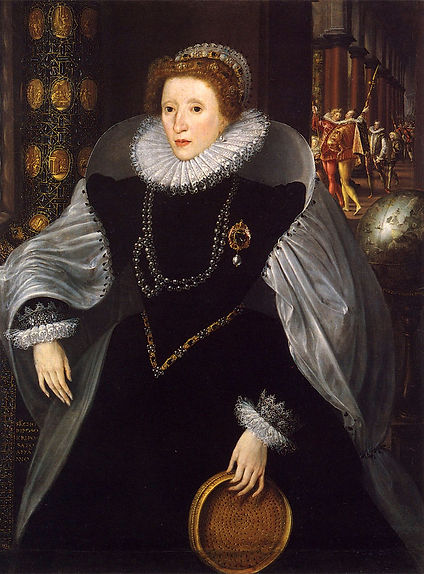
Elizabeth I by Cornelius Ketel, around 1580-1583
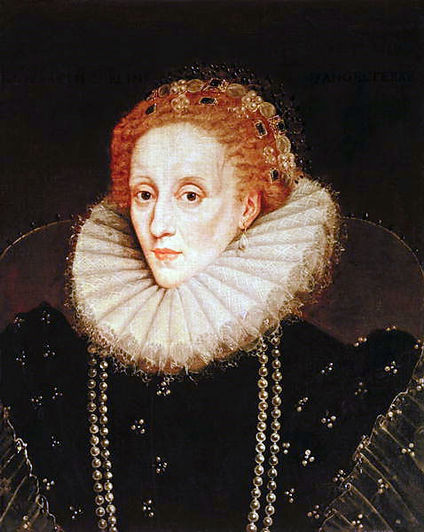
Elizabeth I by Marcus Gheeraerts The Younger, around 1580-1585
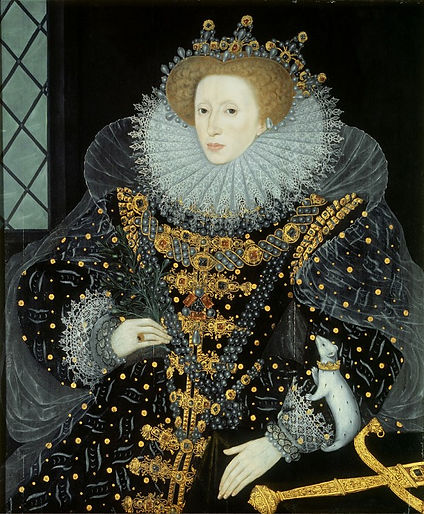
Elizabeth I (The Ermine Portrait) by Nicholas Hilliard, around 1585
On 8 December, Leicester left for the Netherlands, determined to rid England of the Spanish menace once and for all. When he arrived in Flushing on 10 December, Leicester received an ecstatic welcome from the Dutch, who hailed him as their saviour and honoured him nearly three weeks with banquets, fireworks, entertainments and tournaments.
When, on 5 February 1586, Elizabeth learned from one of her ladies that Leicester had accepted the office of Supreme Governor of the Netherlands and been inaugurated at a solemn ceremony at The Hague on 15 January, she exploded with such fury as her courtiers had never before witnessed.
On 5 July, Elizabeth and James VI concluded the Treaty of Berwick, which provided for each monarch to help the other in the event of any invasion. This meant that Philip would not be able to invade England through its northern border. The news of her son's ultimate betrayal reached Mary Stuart just as Anthony Babington was asking her blessing on his plot; it caused her 'the greatest anguish, despair and grief' and gave impetus to her endorsement of the conspiracy.

Mary, Queen of Scots, saying goodbye to those closest to her by Antoine Springael
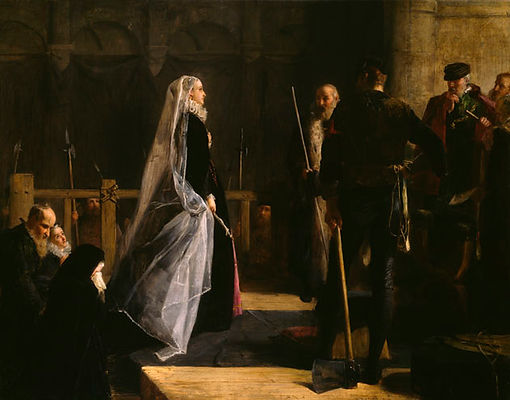
Execution of Mary Stuart by Robert Herdman
The conspiracy was discovered by Walsingham and used to entrap Mary for the purpose of removing her as a claimant to the English throne. On 20 September 1586, Babington and his associates were sentenced to death for treason and conspiracy against the crown, and were hanged, drawn and quartered. In October, Mary was sent to trial at Fotheringhay Castle in Northamptonshire. She was not permitted legal counsel, not permitted to review the evidence against her; and as the Scottish queen, she was convicted of treason against the foreign country of England.
Elizabeth was torn two ways, for the French and Scottish ambassadors were to be vigorous in trying to persuade Elizabeth to show mercy to Mary, and she was anxious not to offend either of these neighbours. For weeks she existed under the most profound stress, which affected her judgement and brought her close to a breakdown.
When the news of the execution reached London, the people went wild with joya and the celebrations lasted for a week. But the queen did not rejoice: when news of Mary's execution was broken to her on 9 February 1587, her reaction was almost hysterical. She erupted, not only in a torrent of weeping, but also in rage against those who had acted on her behalf and driven her to this. Her councillors and courtiers had expected recriminations, but nothing like this, and they trembled in fear at the terrible accusations that were hurled at them.
James VI made no noises expected of cruelly bereaved son, but could not afford to risk alienating Elizabeth, so did nothing beyond issuing a token protest. On 31 March, he declared to his angry nobles that he would not risk the Anglo-Scots alliance by seeking to revenge his mother's death, and asserted his belief that Elizabeth's version of events was the true one.
On 30 July, on the queen's orders, Mary's coffin was at last taken from Fotheringhay Castle for burial; with the coming of summer, it had become something of a health hazard, giving off such a bad smell that no one wished to enter the room where it was kept. It was brought to Peterborough Cathedral, where it was buried with royal honours and great pomp.
In 1612, James I would give orders for his mother's body to be translated to Westminster Abbey, where it was laid to rest in a chapel opposite that in which Elizabeth then lay entombed.
On 29 July 1587, the Pope signed a treaty with Spain, consenting to Philip nominating whoever he pleased as the ruler of England, so long as that person would agree to restore the Catholic faith. In September, Philip ordered Parma to assemble a fleet of barges for the coming invasion. Aware of the preperations being made, Elizabeth rested her hopes on the outcome of the peace talks, knowing that England was in no position to go to war, having no standing army and only a small navy.
Meanwhile, such serious differences had arisen between the English and their Dutch allies that it seemed the Netherlands might erupt in a civil war, and in the autumn, Leicester, whose incompetence was largely to blame, advised the queen that he could be of no further use there. Back at court, he was dismayed to find that, although the queen had received him graciously in public, she was much displeased with his failure to unite with her allies and check the Spanish advance.
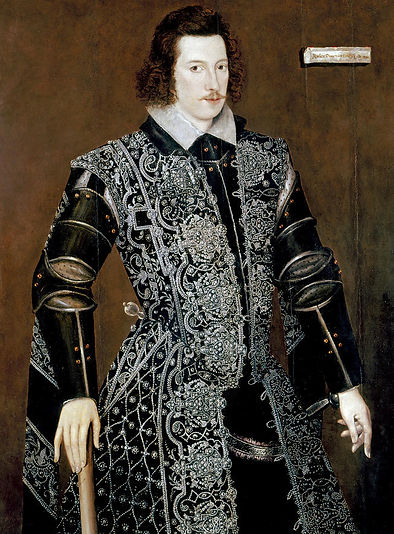
Robert Devereux, Earl of Essex by William Segar, in 1588

Spanish Armada, 1588
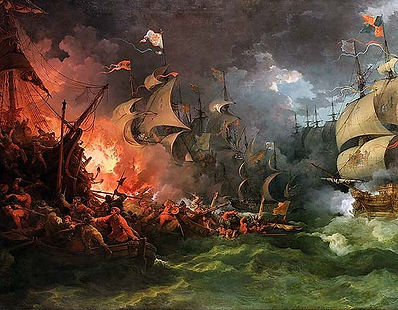
During Leicester's absence in the Netherlands, Earl of Essex had become closer to the queen, using his newly-won power to the advantage of the stepfather who had groomed him to boost his own waning influence. Thanks to the affection between the two men, they never became rivals. Elizabeth was fascinated by the young Essex, finding his company stimulating. He possessed all the attributes she most admired in men, even though she recognised that he lacked political acumen.
Essex was chivalrous, confident and open-handed. He wrote sonnets and stylish lively letters, and acted well in court masques. In appearance, he was 'very tall', with reddish-brown hair and moustache, and elegantly formed hands. Women were susceptible to his charms, his masculinity and his athletic physique, and Elizabeth was no exception, even though she was thirty-three years his senior. This did not, however, preclude the yougn Earl from paying her extravagant compliments or acting as he were lovestruck by her charms. However, she seemed to have regarded him as the son she had never had rather than as a lover or suitor.
Yet there was a darker side to Essex. He could be moody, imperious, petulant and difficult, and, when his temper was roused, he tended to be rashly impulsive. A complex man, he appeared to rush through life, but he was also a dreamer who often inhabited the world of his own, being unaware even of what food he was eating and caring little whether his clothes made up a matching suit. He walked with a long stride, with his head aggressively thrust forward. He was as promiscuous as any other of the court gallants, but after casual sex would hasten to church. And while he loved the dazzle of the court, he often yearned to be at home in the quite of Chartley.
One person who resented Essex's rise was Raleigh, who had thought to replace the ailing Leicester in the queen's affections, but whose star was now eclipsed by the new favourite. Raleigh became obsessively jeolous and determined to topple Essex from his present eminence.
On 21 December 1587, the queen appointed Charles Howard, Lieutenant General, Lord High Admiral and Commander of the English navy, and ordered the fleet to be put on standby. There was no doubt now that Philip would send his Armada soon. She had known his plans since November: the Armada of Spanish galleons was to defeat the English fleet and pave the way for Parma, who would land in England with an army from the Netherlands. When Elizabeth had been deposed, Philip himself would arrive to claim the crown for his daughter and the Catholic faith.
The progress of the Spanish fleet had been impeded by storms, but on 19 July 1588, what the Spaniards was referring to as 'invincible' Armada was first sighted by the English off The Lizard, in Cornwall. As the chain of beacons flared, Elizabeth heard the news on the night of 22 July at Richmond, where the Council would meet daily in emergency session over the next few days. Moving along the south coast, the stately Armada was taking for the Netherlands, whence it would escort Parma's army to England.
Charles Howard put out to sea in pursuit of the Armada after nightfall on the 19th. There was a brief and inconclusive skirmish off Eddystone, near Plymouth, on 21 July, followed later by a more vicious engagement near Portland, in which several Spanish galleons were severely damaged. The English fleet continued to shadow the Armada as it sailed east, neatly avoiding any further engagements by sailing out of range whenever the galleons prepared for battle.
The English had learned more of the Spanish strengths and weaknesses during the skirmishes in the English Channel. They had spent most of their gunpowder in the first engagements and now had been forced to conserve their heavy shot and powder for a final attack near Gravelines on 29 July. With its superior manoeuvrability, the English fleet provoked Spanish fire while staying out of range. The English then closed, firing repeated and damaging broadsides into the enemy ships. The Spanish plan to join with Parma's army had been defeated and the English had gained some breathing space, but the Armada's presence in northern waters still posed a great threat to England.
The Spanish Armada straggled home to Spain in shattered remnants, after disastrous losses on the coast of Ireland. Parma had refused to venture his army without the backing of the Spanish navy. Philip was desolated by the defeat and retreated into his palace of the Escorial near Madrid, seeking to find consolation and understanding in prayer.
The Battle of Gravelines, at which the English fleet dispersed
the Spanish Armada and forced it into the north sea
Unaware of the Armada's fate, English military mustered to defend the country under the Earl of Leicester's command. He invited Elizabeth to inspect her troops at Tilbury in Essex on 8 August.
After the Armada's defeat Leicester was riding in splendour through London 'as if he were a king', and for the past few weeks he had usually dined with the queen. On his way to Buxton to take the baths, he died at Cornbury Park near Woodstock on 4 September 1588. Leicester's health had not been good for some time and historians have considered the stomach cancer as death causes. His death came unexpectedly and only a week earlier he had said farewell to his queen.
Elizabeth was griefstricken by the loss of Leicester, the man who for thirty years had been closer to her than any other, whom she called 'her brother and best friend'. She had no sympathy for the grieving widow and continued to behave as if Lettice Knollys did not exist. Although her marriage appeared to have been happy - in his will, Leicester referred to Lettice as 'a faithful, loving, very obedient, careful wife' - she, probably for financial security, remarried within a year: her third husband was Sir Christopher Blount, a friend of her son - Essex.
After Leicester's death, Elizabeth turned to Essex, who rapidly assumed the role of chief favourite, moving into his stepfather's old apartments at court and being constantly in the queen's company. He thought he could manipulate her, but constantly underestimated her formidable intellect and strength of will. However, such was her affection for him that she would invariably forgive him for minor transgressions: this, again, led him to believe that he could do as he pleased with impunity.
However, he was soon to be disabused of this notion, for in November 1588, the queen's eye alighted again upon Sir Charles Blount, son of Lord Mountjoy, a scholarly youth with 'brown hair, a sweet face, a most neat composure, and tall in his person', whose skill in the joust brought him to her attention. Blount, who had fought in the Netherlands and against the Armada, was ambitious to go abroad to seek martial adventures, but Elizabeth would not hear of it.
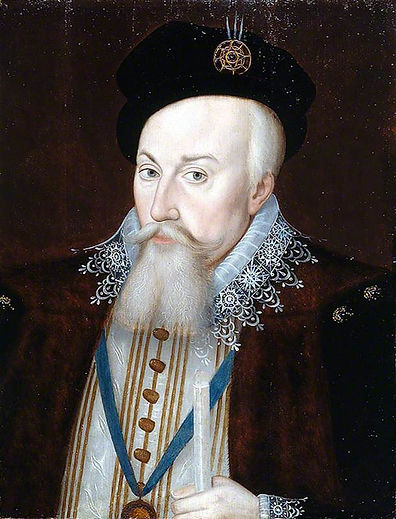
Robert Dudley by William Segar, 1588
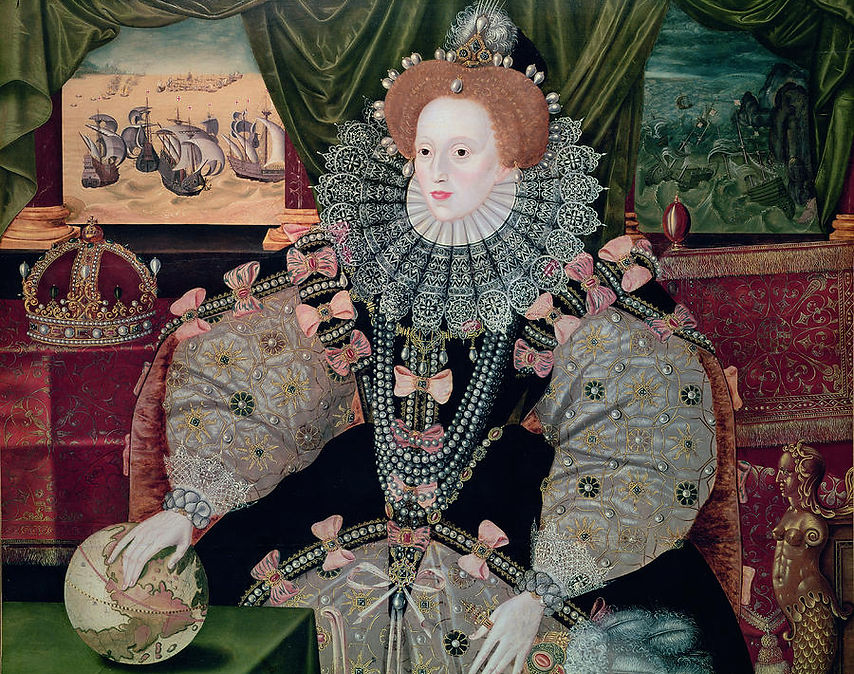
The Armada Portrait by George Gower, 1588
In spring 1589, determined to break Spain's naval strength for good and ensure that Philip would never be able to send another Armada against England, Elizabeth decided to dispatch Francis Drake, John Norris and Walter Raleigh on an expedition to Portugal to destroy the remnants of the enemy fleet and, in concert with a rebellion by Portuguese patriots, place Don Anotnio, the illegitimate Portuguese pretender, on the throne. Essex, hoping for rich pickings to clear his debt, was desperate to go, and when, early in April, the queen forbade it, he defied her and, slipping away from court without leave, rode determinedly to Falmouth. When Elizabeth learned what he had done, Essex was already at the sea. The campaign resulted in the defeat of the English fleet and eventually to a withdrawal with heavy losses both in lives and ships.
In July came the news that Henri III has been assassinated by a fanatical monk, in revenge for his murder of the Duke of Guise. Having no son, he was the last of the Valois dynasty, and was succeeded by his brother-in-law, the Protestant Henri of Navarre, who became Henri IV, the first king of the House of Bourbon.
Worn out with overwork, Sir Francis Walsingham died on 6 April 1590, having almost bankrupted himself in the queen's service: he was buried at night in order to foil creditors who might impound his coffin. He had served Elizabeth faithfully, and with a rumoured fifty agents in the courts of Europe, had preserved her from the evil intentions of her Catholic enemies. Elizabeth did not appoint anyone to co-ordinate Walsingham's spy netowork, nor did she immediately replace him; for the next six years, the Secretary's duties were shouldered by Robert Cecil, whose ability the queen had come to recognise. Burghley had groomed his son to take over, and was much satisfied by his advancement.
Although Elizabeth was never as close to him as to his father, the queen trusted him implicitly. Essex's insistence on regarding Cecil as his rival led to the formation of the factions which were to dominate the last years of Elizabeth's reign and lead to so much squabbling and bribery. Essex and his followers were avid for military glory and the continuance of the war with Spain, while the faction headed by Cecil and Burghley stood for peace and stability.
In the autumn 1590, Elizabeth found out that Essex had secretly married Walsingham's daughter and heiress, Frances, the widow of Sir Philip Sidney. The queen, thinking Frances not good enough for him with no dowry or beauty to speak of, raged for two weeks before allowing herself to be persuaded that Essex had only done what every other man of rank and wealth did, namely, married to beget heirs.
In the summer 1591, Raleigh, who as Captain of the Gentelmen Pensioners was sworn to protect the queen's ladies and held a key to the Maidens' Chamber, secretly seduced or was seduced by the eldest of the maids of honour, Elizabeth (Bess) Throckmorton. She had conceived a child, but Bess was not like Raleigh's other conquests: she began to insist on marriage. That autumn, in great secrecy, Raleigh and Bess were married. Bess remained at court, attending to her duties and doing her best to conceal her pregnancy.

Robert Cecil, 1st Earl of Salisbury by John De Critz The Elder, in 1602
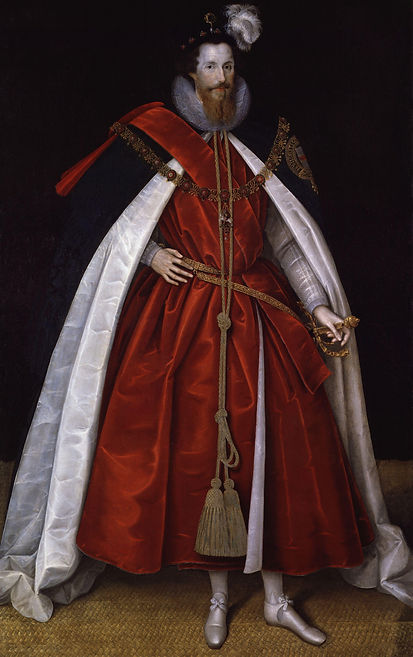
Robert Devereux by Marcus Gheeraerts The Younger, in 1597
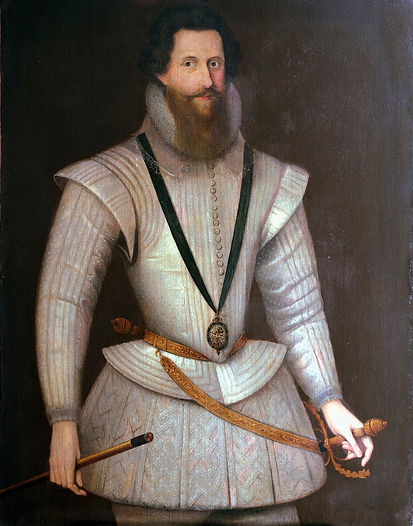
For months now, Henri IV had been sending Elizabeth urgent appeals for aid, for the Spanish were fighting as allies with the Catholic French forces and had occupied parts of Brittany and Normandy. Elizabeth had stalled, not wishing to involve herself in another costly foreign war. Yet she had no desire to see another threatening Spanish army just the other side of the Channel, and that summer 1591 reluctantly consented to send an army to Normandy.
Essex landed with the army in France in August and rode to meet the french king at Compiegne, where he was received with great honour. It soon became clear that he regarded the war as some superior sport: he revelled in his role of commander, exploiting his powers to the full. But he spent the first month doing virtually nothing, waiting for the french king to reduce Noyon. Essex was supposed to be besieging Rouen, but could not do that without French assistance. He therefore entertained, held parades and went hawking in enemy territory, needlessly putting himself at risk and earning a rebuke from the Council. The queen was in fury of frustration at such a waste of time and money, and the fact that Esex did not see fit to inform her of his plans.
Exasperated she ordered him home, although when Essex returned and exerted his charm, peace was restored. After a few days, thanks to Burghley's influence, he was sent back to Rouen to rejoin his troops. The campaign ended in disaster; Essex took the town of Gourney - 'rather a jest than a victory' observed the queen - but that was all. His army succumbed to disease, and morale was low, three thousand men died of illness or deserted, and his brother was killed in a skirmish.
On 3 June 1596, Elizabeth formally appointed Cecil Secretary of State, a post he had filled in all but name since 1590. On the same day, the expedition sailed for Spain, where, the following month, Essex carried out a daring and highly successful raid on the rich port of Cadiz, where some of Philip's ships were being kept in readiness for the invasion of England. Taken unawares, Spanish forces in the area could do little, and for two weeks, English troops ransacked and burned the town, ignoring Essex's orders to spare its churches and religious houses.
Expecting the Spanish to invade in the summer, Essex put pressure on the queen early in 1597 to send another expedition. After the English ships put out to sea on 10 July, a terrible gale raged for four days over southern coast of England and forced to flee back to port. In August, its damaged ships repaired, the fleet sailed again for Spain, but because of further gales it was unable to reach Ferrol, where the Armada was in port. Elizabeth had told Essex that he might go in search of Spanish treasure, but after he had wrecked Philip's navy, yet he now informed her that he was going off in pursuit of the West Indies treasure fleet.
Essex, sailing towards the Azores, arrived on 15 September 1597, the Spanish fleet was expected at any moment, but whilst he searched for them, his own ships became scattered. Raleigh landed at the island of Fayal, and on his own initiative, took a town and seized a great haul of riches. Essex, furious at having been upstaged, accused Raleigh of disobeying orders and of attacking Fayal with the purpose of gaining honour and booty, without thought for his commanding officer.
Had the English fleet seized the Spanish ships Philip would have been forced to sue for peace, but Essex had missed the opportunity and had no choice but to return home empty-handed.
One of Essex's greatest failures was as Lord Lieutenant of Ireland, a post which he talked himself into in 1599. The Nine Years War (1595–1603) was in its middle stages and no English commander had been successful. More military force was required to defeat the Irish, led by Hugh O'Neill, the Earl of Tyrone. Essex led the largest expeditionary force ever sent to Ireland with orders to put an end to the rebellion. Instead of facing Tyrone in battle, Essex had to make a truce with the rebel leader that was considered humiliating to the Crown and to the detriment of English authority.
On 29 November 1599, before a gathering of Privy Councillors, Essex was accused of mismanaging the Irish campaign, squandering public funds, making a dishounourable treaty with Tyrone and abandoning his command against the express orders of the queen.
Throughout the weeks of his confinement, Essex had suffered greatly. He was in pain due to a stone in the kidney and recurring bouts of dysentery, he was allowed to see no one but his servants, he could not go out of doors and his submissive letters to the queen provoked no response, driving him to desperation. He became paranoid, convinced that his misfortunes marked the success of a masterplan by his enemies to destroy him, and that Cecil was not only plotting to murder him, but was also conspiring with Philip III to set the Infanta Isabella on the throne. It was imperative that he warn the queen of what was going on, so that she could rid herself of such treacherous ministers and be reconciled with himself, fully restoring him to favour.
Robert Devereux by Marcus Gheeraerts The Younger, in 1599
During the early weeks of 1601, Essex finalised plans for his coup, which was planned for March, whilst his followers disseminated wild rumours of Catholic plots throughout London. His sense of urgency deepened when, on the morning of 7 February, a messenger arrived from the queen to demand that he present himself before the Coucil immediately. His friends warned him no to go as he would be arrested and urged him to act without delay. On the morning of 8 February, he marched out with a party of nobles and gentlemen and entered the city of London in an attempt to force an audience with the queen.
During the rebellion, Elizabeth had remained in control and displayed remarkable courage, giving orders to Cecil and never doubting her people's loyalty. As Elizabeth wanted the chief offenders brought to trial without delay, the Council began examining them, uncovering the full details of the doomed plot.
On 19 February 1601, Essex was tried before his peers on charges of treason. On the day after the trial, without her usual prevarication, Elizabeth signed his death warrant in a firm hand. On 25 February, Essex was beheaded on Tower Green, becoming the last person to be beheaded in the Tower of London.
Elizabeth never showed any sign of regret for having executed Essex. As far as she was concerned, she had been justified in doing so. Yet she remembered him with sadness, and for the rest of her life wore a ring he had given her. For months after Essex's death, Elizabeth was weary and sad, suffering bouts of depression that drove her seek sanctuary in her darkened bedchamber, where she would give away to fits of weeping. Drained of energy, she grew careless and forgetful when attending to state affairs. The last two years had broken her spirit, and there were few left of her generation to understand her terrible isolation. She was finding it harder to concentrate on state business, and this was exacerbated by failing eyesight.
Although Elizabeth refused to name her successor, speculations on the matter had increased as she grew older. People wanted James of Scotland because he was a Protestant and a married man with two sons. Of the English claimants, most people discounted the claims of Katherine Grey's son, whose legitimacy was questionable, nor were they interested in Arbella Stewart, mainly on accountof her sex.
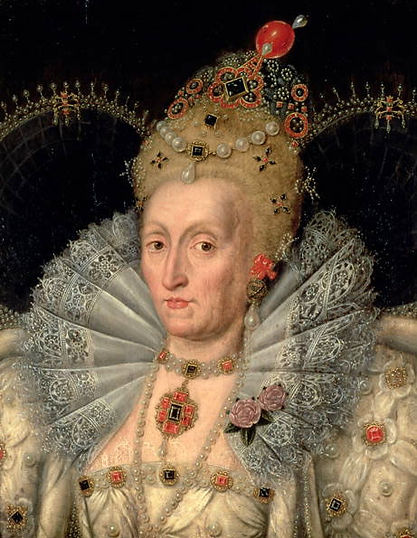
Elizabeth I by Marcus Gheeraerts The Younger, around 1600
The Death of Elizabeth I by Paul Delaroche
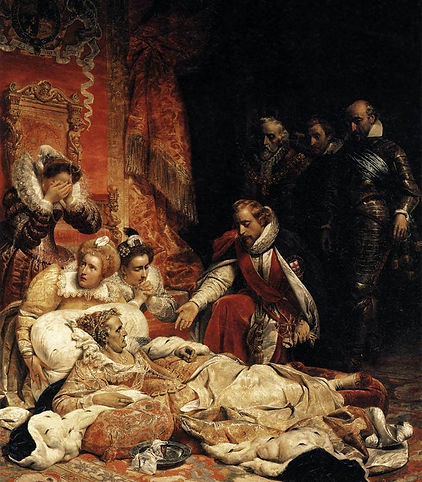
On 25 February 1603, Elizabeth's cousin and closest woman friend, Catherine Howard, Countess of Nottingham, died at Richmond. The queen was present at her deathbed and her grief was such that she ordered a state funeral and sank into deep depression from which she never recovered. At the same time, her coronation ring, which had become painfully embedded in the swollen flesh of her finger, had to be sawn off - an act that symbolised to her the breaking of a sacred bond, the marriage of a queen to her people.
In the beginning of March, a fever had developed and the queen could not sleep or swallow food easily. These problems, which may have been symptomatic of influenza or tonsillitis, were exacerbated by her depression. She spent her days lying on the floor on cushions, lost in 'unremovable melancholy' and unwilling to speak to anyone. It was obvious that she had lost will to live.
By 18 March, her condition had deteriorated alarmingly. At last, on 21 March, Elizabeth was persuaded to go to bed. After lying there for some hours, an abscess or ulcer in her throat burst and she declared she felt better and asked for some of her restorative broth to be made. In the evening, on 23 March, with heavy rain pattering against the windows, Elizabeth turned her face to the wall and fell into a deep sleep from which she would never wake.
On 24 March, the accession of James I was proclaimed at Whitehall. On 28 April, more than a month after her death, Elizabeth's body was taken in procession to Westminster Abbey.
For forty-five years, Elizabeth had given her country peace and stable government - her greatest gift to her people. England had risen from impoverished nation to become one of the greatest powers in Europe. Elizabeth had enjoyed a unique relationship with her subjects, which was never seen before and has never been seen after.